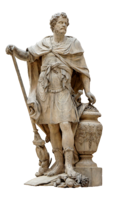Prelude
Hannibal had lifted the siege of Capua after mauling two Roman consular armies in the Battle of Capua. The Roman consuls had split their forces, with Fulvius Flaccus moving towards Cumae, while Appius Claudius Pulcher marched towards Lucania. It is not sure why they had done so, because their forces still outnumbered Hannibal's army, even with the losses suffered in the battle. Hannibal decided to follow Claudius.
Claudius managed to evade the pursuit of Hannibal, but a centurion, Marcus Centenius Penula, had appealed to the Roman Senate for independent command against Hannibal, claiming that with his knowledge of Campania he could best the Carthaginians. His appeal was granted and 4,000 citizen soldiers and 4,000 allies were detached to serve under him, possibly from the army of Gracchus which was stationed in Lucania. To this force another 8,000 volunteers from Campania, Lucania, and Samnium were added.
While Appius Claudius and his consular army marched west to join his fellow consul, Centenius set off to attack Hannibal in Lucania. Hannibal learned of the Romans' approach and halted his pursuit of Claudius. Prior to the battle, Hannibal had his cavalry secure all roads in the area to stop any Roman retreat.
Aftermath
After the battle, Hannibal did not pursue the army of Claudius. Instead, he marched east into Apulia, where a Roman army under Praetor Gnaeus Flavius Flaccus was operating against towns allied to Carthage. The Roman consular armies, free of Hannibal, united and resumed their harassment of Capua. Hanno the Elder remained in Bruttium.
Casualties
Out of 16,000 Romans, only 1,000 survived. These survivors were sent to join the disgraced legions of Cannae survivors after they had been rounded up.
This page is based on this
Wikipedia article Text is available under the
CC BY-SA 4.0 license; additional terms may apply.
Images, videos and audio are available under their respective licenses.



